Kyocera 180, 220 Service manual

TASKalfa 180
TASKalfa 220
SERVICE
MANUAL
Published in September 2009
842KL112
2KLSM062
Rev.2
CAUTION
RISK OF EXPLOSION IF BATTERY IS REPLACED BY AN INCORRECT TYPE. DISPOSE OF USED BATTERIES ACCORDING TO THE INSTRUCTIONS.
It may be illegal to dispose of this battery into the municipal waste stream. Check with your local solid waste officials for details in your area for proper disposal.
ATTENTION
IL Y A UN RISQUE D’EXPLOSION SI LA BATTERIE EST REMPLACEE PAR UN MODELE DE TYPE INCORRECT. METTRE AU REBUT LES BATTERIES UTILISEES SELON LES INSTRUCTIONS DONNEES.
Il peut être illégal de jeter les batteries dans des eaux d’égout municipales. Vérifiez avec les fonctionnaires municipaux de votre région pour les détails concernant des déchets solides et une mise au rebut appropriée.
Revision history
Revision |
Date |
Replaced pages |
Remarks |
|
|
|
|
1 |
August 31, 2009 |
1-2-10, 1-2-11, 1-2-13, 1-3-2, 1-3-3, 1-3-17, 1-3-47, |
- |
|
|
1-5-2, 1-5-13 |
|
|
|
|
|
2 |
September 26, 2009 |
Contents, 1-6-3 |
- |
|
|
|
|

This page is intentionally left blank.
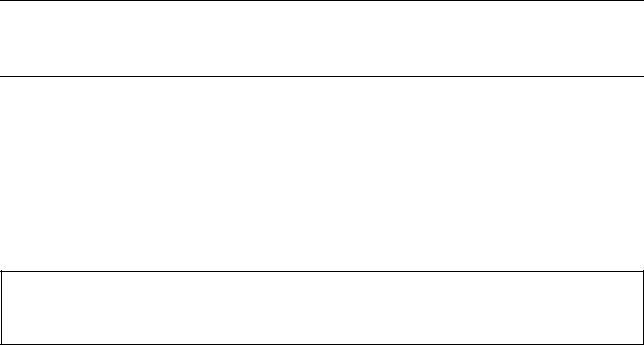
Safety precautions
This booklet provides safety warnings and precautions for our service personnel to ensure the safety of their customers, their machines as well as themselves during maintenance activities. Service personnel are advised to read this booklet carefully to familiarize themselves with the warnings and precautions described here before engaging in maintenance activities.

Safety warnings and precautions
Various symbols are used to protect our service personnel and customers from physical danger and to prevent damage to their property. These symbols are described below:
 DANGER: High risk of serious bodily injury or death may result from insufficient attention to or incorrect compliance with warning messages using this symbol.
DANGER: High risk of serious bodily injury or death may result from insufficient attention to or incorrect compliance with warning messages using this symbol.
 WARNING: Serious bodily injury or death may result from insufficient attention to or incorrect compliance with warning messages using this symbol.
WARNING: Serious bodily injury or death may result from insufficient attention to or incorrect compliance with warning messages using this symbol.
 CAUTION: Bodily injury or damage to property may result from insufficient attention to or incorrect compliance with warning messages using this symbol.
CAUTION: Bodily injury or damage to property may result from insufficient attention to or incorrect compliance with warning messages using this symbol.
Symbols
The triangle ( ) symbol indicates a warning including danger and caution. The specific point of attention is shown inside the symbol.
) symbol indicates a warning including danger and caution. The specific point of attention is shown inside the symbol.
General warning.
Warning of risk of electric shock.
Warning of high temperature.
 indicates a prohibited action. The specific prohibition is shown inside the symbol.
indicates a prohibited action. The specific prohibition is shown inside the symbol.
General prohibited action.
Disassembly prohibited.
 indicates that action is required. The specific action required is shown inside the symbol.
indicates that action is required. The specific action required is shown inside the symbol.
General action required.
Remove the power plug from the wall outlet.
Always ground the copier.

1.Installation Precautions
 WARNING
WARNING
•Do not use a power supply with a voltage other than that specified. Avoid multiple connections to one outlet: they may cause fire or electric shock. When using an extension cable, always check that it is adequate for the rated current. .............................................................................................
•Connect the ground wire to a suitable grounding point. Not grounding the copier may cause fire or electric shock. Connecting the earth wire to an object not approved for the purpose may cause explosion or electric shock. Never connect the ground cable to any of the following: gas pipes, lightning rods, ground cables for telephone lines and water pipes or faucets not approved by the proper authorities. ............................................................................................................................
 CAUTION:
CAUTION:
•Do not place the copier on an infirm or angled surface: the copier may tip over, causing injury. .......
•Do not install the copier in a humid or dusty place. This may cause fire or electric shock. ................
•Do not install the copier near a radiator, heater, other heat source or near flammable material.
This may cause fire. .........................................................................................................................
•Allow sufficient space around the copier to allow the ventilation grills to keep the machine as cool as possible. Insufficient ventilation may cause heat buildup and poor copying performance. ...........
•Always handle the machine by the correct locations when moving it. ...............................................
•Always use anti-toppling and locking devices on copiers so equipped. Failure to do this may cause the copier to move unexpectedly or topple, leading to injury. ...........................................................
•Avoid inhaling toner or developer excessively. Protect the eyes. If toner or developer is accidentally ingested, drink a lot of water to dilute it in the stomach and obtain medical attention immediately. If it gets into the eyes, rinse immediately with copious amounts of water and obtain medical attention. ......................................................................................................................................
•Advice customers that they must always follow the safety warnings and precautions in the copier’s instruction handbook. .....................................................................................................................
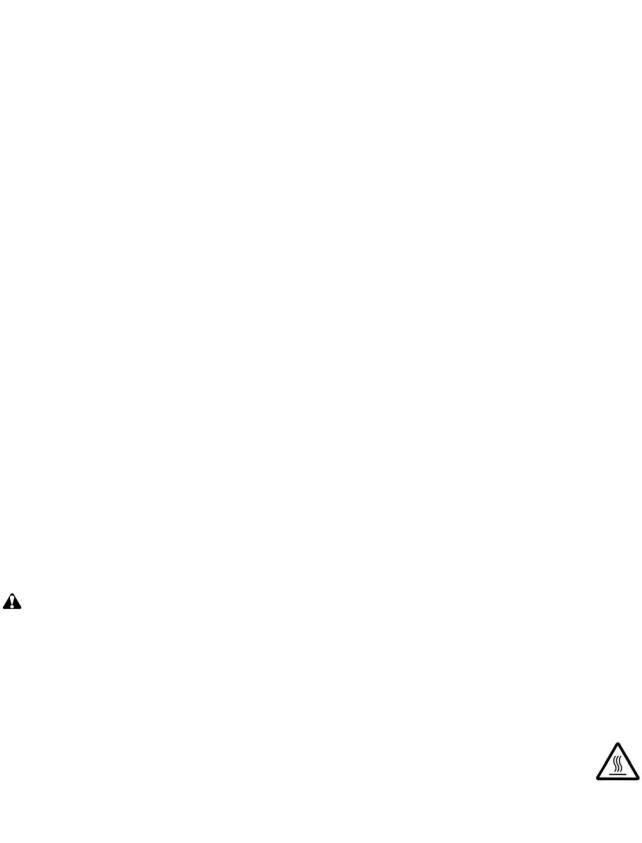
2.Precautions for Maintenance
 WARNING
WARNING
•Always remove the power plug from the wall outlet before starting machine disassembly. ...............
•Always follow the procedures for maintenance described in the service manual and other related brochures. .......................................................................................................................................
•Under no circumstances attempt to bypass or disable safety features including safety mechanisms and protective circuits. .....................................................................................................................
•Always use parts having the correct specifications. ..........................................................................
•Always use the thermostat or thermal fuse specified in the service manual or other related brochure when replacing them. Using a piece of wire, for example, could lead to fire or other serious accident. ..........................................................................................................................................
•When the service manual or other serious brochure specifies a distance or gap for installation of a part, always use the correct scale and measure carefully. ................................................................
•Always check that the copier is correctly connected to an outlet with a ground connection. .............
•Check that the power cable covering is free of damage. Check that the power plug is dust-free. If it is dirty, clean it to remove the risk of fire or electric shock. ..............................................................
•Never attempt to disassemble the optical unit in machines using lasers. Leaking laser light may damage eyesight. ...........................................................................................................................
•Handle the charger sections with care. They are charged to high potentials and may cause electric shock if handled improperly. ............................................................................................................
CAUTION
•Wear safe clothing. If wearing loose clothing or accessories such as ties, make sure they are safely secured so they will not be caught in rotating sections. ..........................................................
•Use utmost caution when working on a powered machine. Keep away from chains and belts. ........
•Handle the fixing section with care to avoid burns as it can be extremely hot. ..................................
•Check that the fixing unit thermistor, heat and press rollers are clean. Dirt on them can cause abnormally high temperatures. ........................................................................................................

•Do not remove the ozone filter, if any, from the copier except for routine replacement. ....................
•Do not pull on the AC power cord or connector wires on high-voltage components when removing them; always hold the plug itself. .....................................................................................................
•Do not route the power cable where it may be stood on or trapped. If necessary, protect it with a cable cover or other appropriate item. .............................................................................................
•Treat the ends of the wire carefully when installing a new charger wire to avoid electric leaks. ........
•Remove toner completely from electronic components. ...................................................................
•Run wire harnesses carefully so that wires will not be trapped or damaged. ....................................
•After maintenance, always check that all the parts, screws, connectors and wires that were removed, have been refitted correctly. Special attention should be paid to any forgotten connector, trapped wire and missing screws. ...................................................................................................
•Check that all the caution labels that should be present on the machine according to the instruction handbook are clean and not peeling. Replace with new ones if necessary. ......................................
•Handle greases and solvents with care by following the instructions below: .....................................
·Use only a small amount of solvent at a time, being careful not to spill. Wipe spills off completely.
·Ventilate the room well while using grease or solvents.
·Allow applied solvents to evaporate completely before refitting the covers or turning the power switch on.
·Always wash hands afterwards.
•Never dispose of toner or toner bottles in fire. Toner may cause sparks when exposed directly to fire in a furnace, etc. .......................................................................................................................
•Should smoke be seen coming from the copier, remove the power plug from the wall outlet immediately. ............................................................................................................................................
3.Miscellaneous
 WARNING
WARNING
•Never attempt to heat the drum or expose it to any organic solvents such as alcohol, other than the specified refiner; it may generate toxic gas. .....................................................................................

This page is intentionally left blank.
|
|
|
2KL/2KK |
|
|
CONTENTS |
|
1-1 Specifications |
|
||
1-1-1 Specifications.......................................................................................................................................... |
1-1-1 |
||
1-1-2 |
Parts names............................................................................................................................................ |
1-1-3 |
|
|
(1) |
Body .................................................................................................................................................. |
1-1-3 |
|
(2) |
Operation panel................................................................................................................................. |
1-1-4 |
1-1-3 |
Machine cross section ............................................................................................................................ |
1-1-5 |
|
1-2 Installation |
|
||
1-2-1 |
Installation environment ......................................................................................................................... |
1-2-1 |
|
1-2-2 |
Unpacking and installation ...................................................................................................................... |
1-2-2 |
|
|
(1) |
Installation procedure ........................................................................................................................ |
1-2-2 |
|
(2) |
Setting initial copy modes................................................................................................................ |
1-2-10 |
1-2-3 Installing the key counter (option) ......................................................................................................... |
1-2-11 |
||
1-2-4 Installing the cassette heater (option) ................................................................................................... |
1-2-16 |
||
1-3 Maintenance Mode |
|
||
1-3-1 |
Maintenance mode ................................................................................................................................. |
1-3-1 |
|
|
(1) |
Executing a maintenance item .......................................................................................................... |
1-3-1 |
|
(2) |
Maintenance mode item list............................................................................................................... |
1-3-2 |
|
(3) |
Contents of maintenance mode items............................................................................................... |
1-3-5 |
1-3-2 |
Management mode ............................................................................................................................... |
1-3-65 |
|
|
(1) |
Using the management mode ......................................................................................................... |
1-3-65 |
|
(2) |
Job accounting ................................................................................................................................ |
1-3-66 |
|
(3) |
Default setting ................................................................................................................................. |
1-3-66 |
1-4 Troubleshooting |
|
||
1-4-1 |
Paper misfeed detection ......................................................................................................................... |
1-4-1 |
|
|
(1) |
Paper misfeed indication ................................................................................................................... |
1-4-1 |
|
(2) |
Paper misfeed detection conditions .................................................................................................. |
1-4-2 |
|
(3) |
Paper misfeeds ................................................................................................................................. |
1-4-8 |
1-4-2 Self-diagnosis ....................................................................................................................................... |
1-4-15 |
||
|
(1) |
Self-diagnostic function ................................................................................................................... |
1-4-15 |
|
(2) |
Self diagnostic codes ...................................................................................................................... |
1-4-16 |
1-4-3 |
Image formation problems .................................................................................................................... |
1-4-21 |
|
|
(1) |
No image appears (entirely white)................................................................................................... |
1-4-22 |
|
(2) |
No image appears (entirely black)................................................................................................... |
1-4-22 |
|
(3) |
Image is too light. ............................................................................................................................ |
1-4-23 |
|
(4) |
Background is visible....................................................................................................................... |
1-4-23 |
|
(5) |
A white line appears longitudinally. ................................................................................................. |
1-4-23 |
|
(6) |
A black line appears longitudinally. ................................................................................................. |
1-4-24 |
|
(7) |
A black line appears laterally........................................................................................................... |
1-4-24 |
|
(8) |
One side of the copy image is darker than the other....................................................................... |
1-4-24 |
|
(9) |
Black dots appear on the image...................................................................................................... |
1-4-24 |
|
(10) |
Image is blurred............................................................................................................................... |
1-4-25 |
|
(11) |
The leading edge of the image is consistently misaligned with the original. ................................... |
1-4-25 |
|
(12) |
The leading edge of the image is sporadically misaligned with the original.................................... |
1-4-25 |
|
(13) |
Paper creases. ................................................................................................................................ |
1-4-25 |
|
(14) |
Offset occurs. .................................................................................................................................. |
1-4-26 |
|
(15) |
Image is partly missing.................................................................................................................... |
1-4-26 |
|
(16) |
Fusing is poor.................................................................................................................................. |
1-4-26 |
|
(17) |
Image is out of focus. ...................................................................................................................... |
1-4-26 |
|
(18) |
Image center does not align with the original center....................................................................... |
1-4-27 |
1-4-4 |
Electric problems .................................................................................................................................. |
1-4-28 |
|
1-4-5 |
Mechanical problems ............................................................................................................................ |
1-4-32 |
|
1-5 Assembly and Disassembly |
|
||
1-5-1 Precautions for assembly and disassembly............................................................................................ |
1-5-1 |
||
|
(1) |
Precautions ....................................................................................................................................... |
1-5-1 |
|
(2) |
Drum.................................................................................................................................................. |
1-5-1 |
|
(3) |
Toner ................................................................................................................................................. |
1-5-1 |
2KL/2KK-2
|
(4) |
How to tell a genuine Kyocera Mita toner container.......................................................................... |
1-5-2 |
1-5-2 |
Paper feed section .................................................................................................................................. |
1-5-3 |
|
|
(1) |
Detaching and refitting the separation pulley .................................................................................... |
1-5-3 |
|
(2) |
Detaching and refitting the forwarding pulley and paper feed pulley................................................. |
1-5-6 |
|
(3) |
Detaching and refitting the paper conveying unit .............................................................................. |
1-5-9 |
|
(4) |
Detaching and refitting the MP paper feed pulley and MP separation pad ..................................... |
1-5-11 |
|
(5) |
Detaching and refitting the left registration roller............................................................................. |
1-5-14 |
|
(6) |
Detaching and refitting the right registration roller........................................................................... |
1-5-15 |
1-5-3 |
Optical section ...................................................................................................................................... |
1-5-17 |
|
|
(1) |
Detaching and refitting the exposure lamp...................................................................................... |
1-5-17 |
|
(2) |
Detaching and refitting the scanner wires ....................................................................................... |
1-5-19 |
|
|
(2-1) Detaching the scanner wires ................................................................................................... |
1-5-19 |
|
|
(2-2) Fitting the scanner wires ......................................................................................................... |
1-5-22 |
|
(3) |
Detaching and refitting the ISU (reference)..................................................................................... |
1-5-26 |
|
(4) |
Detaching and refitting the laser scanner unit................................................................................. |
1-5-28 |
|
(5) |
Adjusting the longitudinal squareness (reference) .......................................................................... |
1-5-33 |
1-5-4 |
Drum section......................................................................................................................................... |
1-5-34 |
|
|
(1) |
Detaching and refitting the drum unit .............................................................................................. |
1-5-34 |
|
(2) |
Detaching and refitting the drum separation claws ......................................................................... |
1-5-35 |
|
(3) |
Detaching and refitting the main charger unit.................................................................................. |
1-5-36 |
1-5-5 |
Developing section................................................................................................................................ |
1-5-37 |
|
|
(1) |
Detaching and refitting the developing unit ..................................................................................... |
1-5-37 |
1-5-6 |
Transfer section .................................................................................................................................... |
1-5-38 |
|
|
(1) |
Detaching and refitting the transfer roller ........................................................................................ |
1-5-38 |
1-5-7 |
Fuser section ........................................................................................................................................ |
1-5-40 |
|
|
(1) |
Detaching and refitting the fuser unit............................................................................................... |
1-5-40 |
|
(2) |
Detaching and refitting the press roller............................................................................................ |
1-5-42 |
|
(3) |
Detaching and refitting the fuser heater .......................................................................................... |
1-5-44 |
|
(4) |
Detaching and refitting the heat roller separation claws.................................................................. |
1-5-47 |
|
(5) |
Detaching and refitting the heat roller ............................................................................................. |
1-5-48 |
|
(6) |
Detaching and refitting the fuser thermistor .................................................................................... |
1-5-50 |
|
(7) |
Detaching and refitting the fuser thermostat ................................................................................... |
1-5-51 |
|
(8) |
Adjusting front position of the fuser unit (adjusting lateral squareness) .......................................... |
1-5-52 |
1-5-8 Others ................................................................................................................................................... |
1-5-53 |
||
|
(1) |
Detaching and refitting the eject unit............................................................................................... |
1-5-53 |
|
(2) |
Direction of installing the principal fan motors................................................................................. |
1-5-55 |
1-6 Requirements on PWB Replacement
1-6-1 |
Upgrading the firmware........................................................................................................................... |
1-6-1 |
|
1-6-2 |
Adjustment-free variable resistors (VR) .................................................................................................. |
1-6-2 |
|
1-6-3 |
Remarks on main/engine PWB replacement .......................................................................................... |
1-6-2 |
|
1-6-4 |
Upgrading the printing system firmware ................................................................................................. |
1-6-3 |
|
|
(1) |
Upgrade using PC/USB..................................................................................................................... |
1-6-3 |
|
(2) |
Upgrade using DIMM ........................................................................................................................ |
1-6-3 |
2-1 Mechanical construction
2-1-1 |
Paper feed section .................................................................................................................................. |
2-1-1 |
|
2-1-2 |
Optical section ........................................................................................................................................ |
2-1-3 |
|
|
(1) |
Image scanner section ...................................................................................................................... |
2-1-3 |
|
(2) |
Laser scanner section ....................................................................................................................... |
2-1-5 |
2-1-3 |
Drum section........................................................................................................................................... |
2-1-7 |
|
2-1-4 |
Developing section.................................................................................................................................. |
2-1-9 |
|
|
(1) |
Single component developing system............................................................................................. |
2-1-11 |
2-1-5 Transfer and separation sections.......................................................................................................... |
2-1-12 |
||
2-1-6 |
Fuser section ........................................................................................................................................ |
2-1-13 |
|
2-1-7 Eject and switchback sections .............................................................................................................. |
2-1-15 |
||
2-1-8 |
Duplex section ...................................................................................................................................... |
2-1-17 |
|
2-2 Electrical Parts Layout
2-2-1 Electrical parts layout.............................................................................................................................. |
2-2-1 |
|
(1) |
PWBs ................................................................................................................................................ |
2-2-1 |
(2) |
Switches and sensors ....................................................................................................................... |
2-2-3 |
(3) |
Motors ............................................................................................................................................... |
2-2-4 |
|
|
2KL/2KK-2 |
|
(4) Others................................................................................................................................................ |
2-2-5 |
2-3 Operation of the PWBs |
|
|
2-3-1 |
Power source PWB................................................................................................................................. |
2-3-1 |
2-3-2 |
Main/engine PWB ................................................................................................................................... |
2-3-3 |
2-3-3 |
Cassette PWB....................................................................................................................................... |
2-3-11 |
2-3-4 |
Operation PWB ..................................................................................................................................... |
2-3-14 |
2-4 Appendixes |
|
|
|
Maintenance parts list ............................................................................................................................. |
2-4-1 |
|
Periodic maintenance procedures .......................................................................................................... |
2-4-2 |
|
Chart of image adjustment procedures................................................................................................... |
2-4-5 |
|
Wiring diagram........................................................................................................................................ |
2-4-7 |
INSTALLATION GUIDE
DOCUMENT PROCESSOR
PAPER FEEDER
DUPLEX UNIT
Printing System (Z)

2KL/2KK
This page is intentionally left blank.
2KL/2KK
1-1-1 Specifications
Type ................................................ |
Desktop |
|
Printing system ............................... |
Indirect electrostatic system |
|
Supported original types ................. |
Sheets, books and three-dimensional objects |
|
|
Maximum original size: A3/Ledger |
|
Original feed system ....................... |
Fixed |
|
Paper weight................................... |
Cassette: 64 - 105 g/m2 |
|
|
MP tray: 45 - 160 g/m2 |
|
Paper type ...................................... |
Cassette: Plain, Rough, Recycled, Preprinted, Bond, Color (Colour), Prepunched, |
|
|
Letterhead, High Quality, Custom 1 to 8 |
|
|
MP tray: Plain, Transparency (OHP film), Rough, Vellum, Labels, Recycled, |
|
|
Preprinted, Bond, Cardstock, Color (Colour), Prepunched, Letterhead, |
|
|
Thick, Envelope, High Quality, Custom 1 to 8 |
|
Paper size....................................... |
Cassette: A3, B4, A4, A4R, B5, B5R, A5R, Folio, Ledger, Legal, Letter, LetterR, |
|
|
StatementR, Oficio II, 8K, 16K |
|
|
MP tray: A3, B4, A4, A4R, B5, B5R, A5R, B6R, A6R, Folio, Ledger, Legal, Letter, |
|
|
LetterR, Statement, Oficio II, 8K, 16K |
|
|
A3, B4, A4, A4R, B5, B5R, A5R, B6R, A6R, Folio, Ledger, Legal, Letter, |
|
|
LetterR, Hagaki, Oufuku Hagaki, Envelope DL, Envelope C5, Envelope C4, |
|
|
Envelope #10 (Comm. #10), Envelope #9 (Comm. #9), Envelope #6 |
|
|
(Comm. #6 3/4), Envelope Monarch, ISO B5, Youkei 2, Youkei 4, Executive, |
|
|
Statement, Oficio II, 8K, 16K, 16KR, |
|
Zoom level ...................................... |
Manual mode: 25 to 400%, 1% increments |
|
|
Auto mode: Preset zoom |
|
Printing speed................................. |
18 ppm model |
|
|
A4/Letter: |
18 sheets/min. |
|
A4R/LetterR: 13 sheets/min. |
|
|
A3/Ledger: |
8 sheets/min. |
|
B4/Legal: |
8 sheets/min. |
|
B5: |
16 sheets/min. |
|
B5R: |
13 sheets/min. |
|
A5R: |
10 sheets/min. |
|
22 ppm model |
|
|
A4/Letter: |
22 sheets/min. |
|
A4R/LetterR: 13 sheets/min. |
|
|
A3/Ledger: |
10 sheets/min. |
|
B4/Legal: |
11 sheets/min. |
|
B5: |
20 sheets/min. |
|
B5R: |
13 sheets/min. |
|
A5R: |
10 sheets/min. |
First copy time ................................ |
5.7 s or less |
|
Warm-up time ................................. |
Room temperature 22 °C/71.6 °F, 60% RH |
|
|
Power on: |
17.2 s |
|
Low power mode:10 s |
|
|
Sleep mode: |
17.2 s |
Paper capacity ................................ |
Cassette: 300 sheets (80 g/m2), |
|
|
150 sheets (90 g/m2 or more) |
|
|
MP tray: 100 sheets (A4/Letter or less), |
|
|
25 sheets (B4/Legal or more) |
|
Output tray capacity........................ |
Top tray: 250 sheets (80 g/m2) |
|
Continuous copying ........................ |
1 to 999 sheets |
|
Light source .................................... |
Inert gas lamp |
|
Scanning system ............................ |
Flat bed scanning by CCD image sensor |
|
Photoconductor............................... |
OPC (drum diameter 30 mm) |
|
Image write system......................... |
Semiconductor laser |
|
Charging system............................. |
Single positive corona charging |
|
Developing system ......................... |
Single component developing system |
|
|
Toner: magnetism toner |
|
|
Toner replenishing: Automatic from a toner container |
|
Transfer system .............................. |
Transfer roller |
|
Separation system .......................... |
Curvature separation and separation electrode |
|
Cleaning system ............................. |
Blade and cleaning roller |
|
|
|
1-1-1 |
2KL/2KK |
|
Charge erasing system................... |
Exposure by cleaning lamp |
Fusing system................................. |
Heat roller |
|
Heat source: Halogen heaters |
|
Abnormally high temperature protection devices: thermostats |
Main memory .................................. |
Standard: 32 MB |
|
Maximum: 160 MB |
Interface.......................................... |
USB interface connector: 1 (USB Hi-speed) |
|
Network interface: 1 (10 BASE-T/100 BASE-TX) |
Resolution....................................... |
600 x 600 dpi |
Operating environment ................... |
Temperature: 10 to 32.5°C/50 to 90.5°F |
|
Humidity: 15 to 80% RH |
|
Altitude: 2500 m/8,202 ft maximum |
|
Brightness: 1500 lux maximum |
Dimensions ..................................... |
568 (W) x 546 (D) x 502 (H) mm (main body only) |
|
22 3/8" (W) x 21 1/2" (D) x 19 3/4" (H) (main body only) |
Weight............................................. |
33 kg/72.8 lbs |
Space required................................ |
838 mm (W) x 546 (D) mm (using MP tray) |
|
33" (W) x 21 1/2" (D) (using MP tray) |
Power source.................................. |
120 V AC, 60 Hz, 9.7 A |
|
220 to 240 V AC, 50 Hz, 5.1 A |
Options ........................................... |
Document processor, paper feeder, duplex unit, key counter, printer kit and expansion |
|
memory |
Duplex unit |
|
Type ................................................ |
Internal type |
Paper weight................................... |
64 - 105 g/m2 |
Paper type ...................................... |
Plain, Recycled |
Paper size....................................... |
A3, B4, A4, A4R, B5, B5R, A5R, Folio, Ledger, Legal, Letter, LetterR, |
|
StatementR, Oficio II, 8K, 16K |
Power source.................................. |
Electrically connected to the machine. |
Dimensions ..................................... |
363 (W) x 54 (D) x 181 (H) mm |
|
14 5/16" (W) x 2 1/8" (D) x 7 1/8" (H) |
Weight............................................. |
0.5 kg or less / 1.1 lbs or less |
NOTE: These specifications are subject to change without notice.
1-1-2
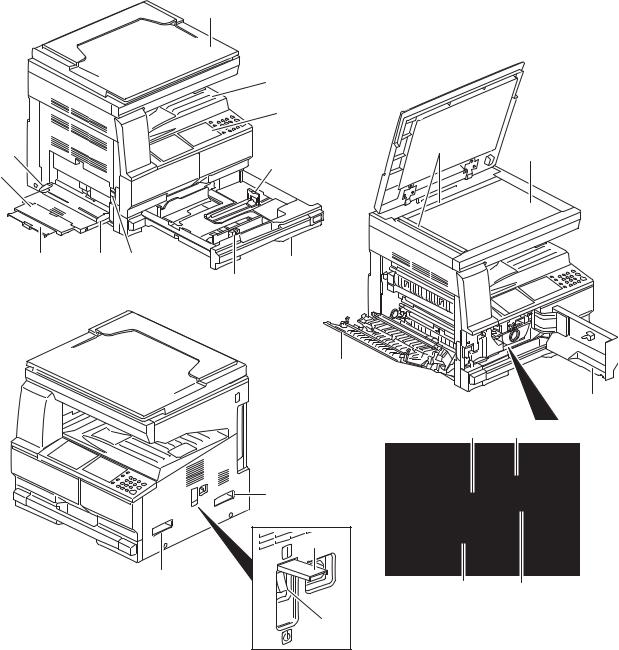
2KL/2KK
1-1-2 Parts names
(1) Body
1
|
2 |
|
|
|
3 |
|
|
10 |
12 |
11 |
|
6 |
|||
|
|
8
9 |
10 |
7 |
4 |
|
|
|
5
|
|
|
13 |
|
|
|
|
|
|
|
|
|
14 |
|
|
|
|
|
17 |
15 |
|
|
|
19 |
|
|
|
|
|
|
21 |
|
|
|
|
19 |
|
|
|
|
|
|
|
|
|
|
18 |
16 |
|
|
|
20 |
|
|
|
|
|
|
Figure 1-1-1 |
|
|
|
1. |
Original cover (option) |
8. |
MP tray |
15. |
Toner container release lever |
|
2. |
Output tray |
9. |
MP tray extension |
16. |
Toner container |
|
3. |
Operation panel |
10. |
Slider |
17. |
Charger cleaner rod |
|
4. |
Cassette |
11. |
Contact glass |
18. |
Waste toner box |
|
5. |
Paper width adjusting tab |
12. |
Original size indicator plates |
19. |
Handles for transport |
|
6. |
Paper length adjusting tab |
13. |
Left cover |
20. |
Main power switch |
|
7. |
Left cover handle |
14. |
Front cover |
21. |
Main power switch cover |
|
1-1-3
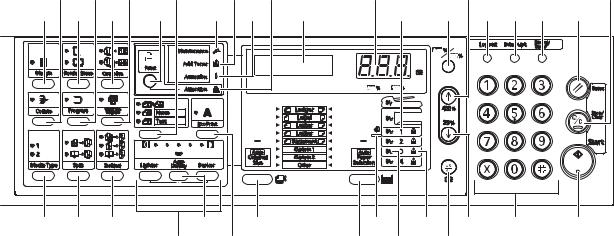
2KL/2KK
(2) Operation panel
36 |
33 |
30 |
27 |
25 |
|
23 |
|
18 |
|
9 |
|
|
2 |
37 |
34 |
31 |
28 |
26 |
24 |
19 |
|
13 |
11 |
7 |
6 |
5 |
3 |
35 |
32 |
29 |
|
21 |
17 |
|
|
15 |
12 |
8 |
4 |
|
1 |
|
|
|
22 |
20 |
|
|
16 |
14 |
10 |
|
|
|
|
|
|
|
|
|
|
Figure 1-1-2 |
|
|
|
|
|
|
|
1. |
Start key |
20. |
EcoPrint key |
2. |
Stop/Clear key |
21. |
Auto density key |
3. |
Reset key |
22. |
Density adjustment key/Density display |
4. |
Numeric keys |
23. |
Attention indicator |
5. |
Energy saver key |
24. |
Error Indicator |
6. |
Interrupt key |
25. |
Add toner indicator |
7. |
Logout key |
26. |
Maintenance indicator |
8. |
Zoom + key |
27. |
Image quality selection key |
9. |
Zoom - key |
28. |
Printer Key |
10. |
OK Key |
29. |
2-sided key |
11. |
Auto%100% key |
30. |
Mixed original size key |
12. |
Paper supply indicator |
31. |
Combine key |
13. |
Paper supply level indicator |
32. |
Split key |
14. |
Paper misfeed indicator |
33. |
Program key |
15. |
MP indicator |
34. |
Border erase key |
16. |
Paper selection key |
35. |
Media type key |
17. |
Original size key |
36. |
Collate key |
18. |
No. of copies/Zoom display |
37. |
Margin key |
19. |
Message display |
|
|
1-1-4

2KL/2KK
1-1-3 Machine cross section
2
7 |
|
6 |
2 |
|
3 |
8 |
|
5 |
4 |
|
|
|
1 |
 Light path
Light path
 Paper path
Paper path
Figure 1-1-3 Machine cross section
1.Paper feed section
2.Optical section
3.Drum section
4.Developing section
5.Transfer and separation sections
6.Fuser section
7.Eject and switchback sections
8.Duplex section
1-1-5

2KL/2KK
This page is intentionally left blank.
1-1-6
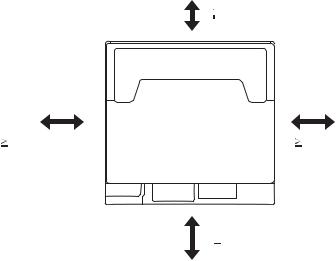
2KL/2KK
1-2-1 Installation environment
1.Temperature: 10 to 32.5°C/50 to 90.5°F
2.Humidity: 15 to 80% RH
3.Power supply: 120 V AC, 9.7 A
220 to 240 V AC, 5.1 A
4.Power source frequency: 50 Hz ± 0.3%/60 Hz ± 0.3%
5.Installation location
Avoid direct sunlight or bright lighting. Ensure that the photoconductor will not be exposed to direct sunlight or other strong light when removing paper jams.
Avoid locations subject to high temperature and high humidity or low temperature and low humidity; an abrupt change in the environmental temperature; and cool or hot, direct air.
Avoid places subject to dust and vibrations.
Choose a surface capable of supporting the weight of the machine.
Place the machine on a level surface (maximum allowance inclination: 1°).
Avoid air-borne substances that may adversely affect the machine or degrade the photoconductor, such as mercury, acidic of alkaline vapors, inorganic gasses, NOx, SOx gases and chlorine-based organic solvents.
Select a well-ventilated location.
6.Allow sufficient access for proper operation and maintenance of the machine. Machine front: 1000 mm/39 3/8" Machine rear: 100 mm/3 15/16"
Machine right: 300 mm/11 13/16" Machine left: 300 mm/11 13/16

 100 mm/3 15/16"
100 mm/3 15/16"
300 mm/11 13/16" |
300 mm/11 13/16" |
 1000 mm/39 3/8"
1000 mm/39 3/8"
Figure 1-2-1 Installation dimensions
1-2-1

2KL/2KK
1-2-2 Unpacking and installation
(1) Installation procedure
Start
Unpack.
Remove the tapes.
Install the optional paper feeder.
Release the scanner pins.
Install the optional original cover or the DP.
Install other optional devices.
Install the toner container.
Install the waste toner box.
Load paper.
Connect the power cord.
Installing toner.
Output an own-status report (maintenance item U000).
Exit maintenance mode.
Make test copies.
Attaching the operation label.
Attaching the cover label.
Completion of the machine installation.
1-2-2
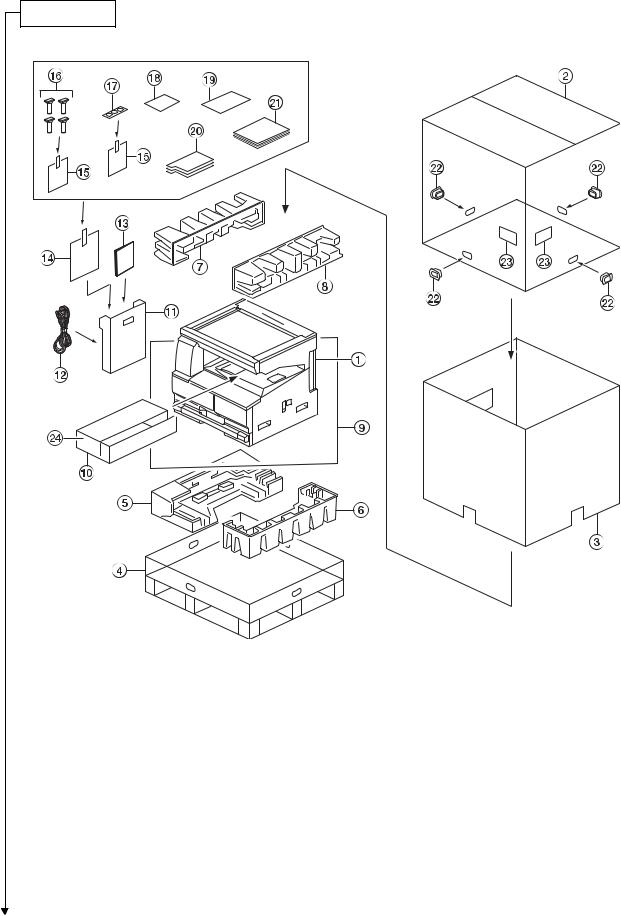
2KL/2KK
Unpacking.
|
Figure 1-2-2 Unpacking |
||
1. |
Machine |
14. |
Plastic bag |
2. |
Outer case |
15. |
Plastic bag |
3. |
Inner frame |
16. |
Cursor pins |
4. |
Skid |
17. |
Cover label |
5. |
Bottom left pad |
18. |
Cassette size labels |
6. |
Bottom right pad |
19. |
Operation label A |
7. |
Top left pad |
20. |
Operation label B |
8. |
Top right pad |
21. |
Operation guide* |
9. |
Machine cover |
22. |
Hinge joints |
10. |
Eject spacer |
23. |
Barcode labels |
11. |
Document tray |
24. |
Toner container |
12. |
Power cord |
|
|
13. |
Paper storage bags |
*: 120 V specifications only |
|
Caution: Place the machine on a level surface.
1-2-3
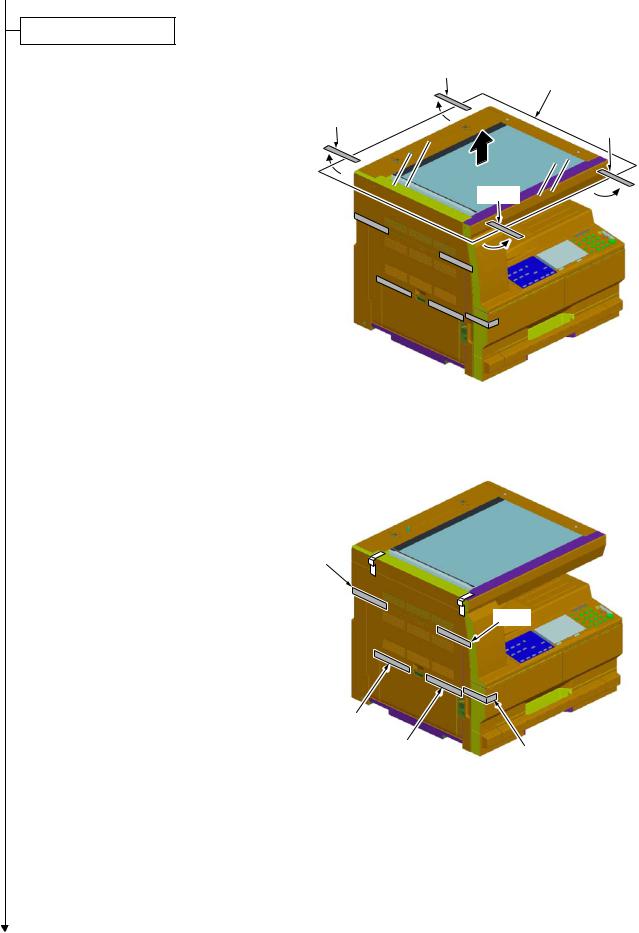
2KL/2KK
Remove the tapes.
1.Remove four tapes and remove the plastic sheet.
Tape
Plastic sheet
Tape
Tape
Tape
Figure 1-2-3
2. Remove five tapes.
Tape
Tape
Tape
Tape
Tape
Figure 1-2-4
1-2-4
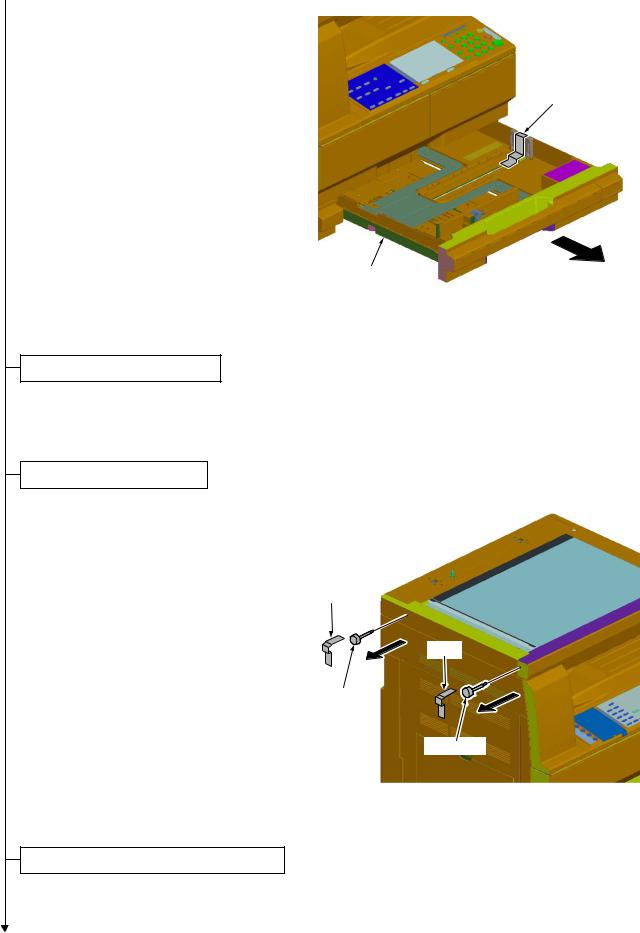
2KL/2KK
3.Pull the cassette out.
4.Remove the tapes.
5.Push the cassette back in.
Tape
Cassette
Figure 1-2-5
Install the optional paper feeder.
1.Install the optional paper feeder as necessary.
Release the scanner pins.
1.Remove two tapes.
2.Remove two scanner pins.
Tape
Tape
Scanner pin
Scanner pin
Figure 1-2-6
Install the optional original cover or the DP.
1. Install the optional original cover or DP.
1-2-5
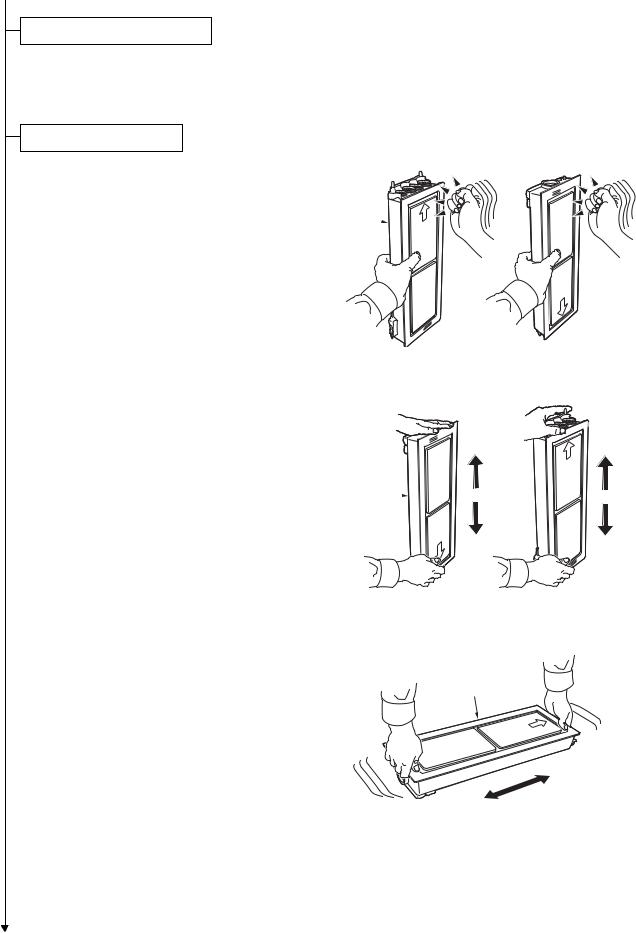
2KL/2KK
Install other optional devices.
1.Install the optional devices (duplex unit and/ or printer kit etc.) as necessary.
Install the toner container.
1.Open the front cover.
2.Hold the toner container vertically and tap the upper part five times or more.
Turn the toner container upside down and tap the upper part five times or more.
3.Shake the toner container up and down five times or more.
Turn the toner container upside down and shake it five times or more.
4.Shake the toner container approximately five times in the horizontal direction to stir toner.
Toner container 
Figure 1-2-7
Toner container 
Figure 1-2-8
Toner container
Figure 1-2-9
1-2-6
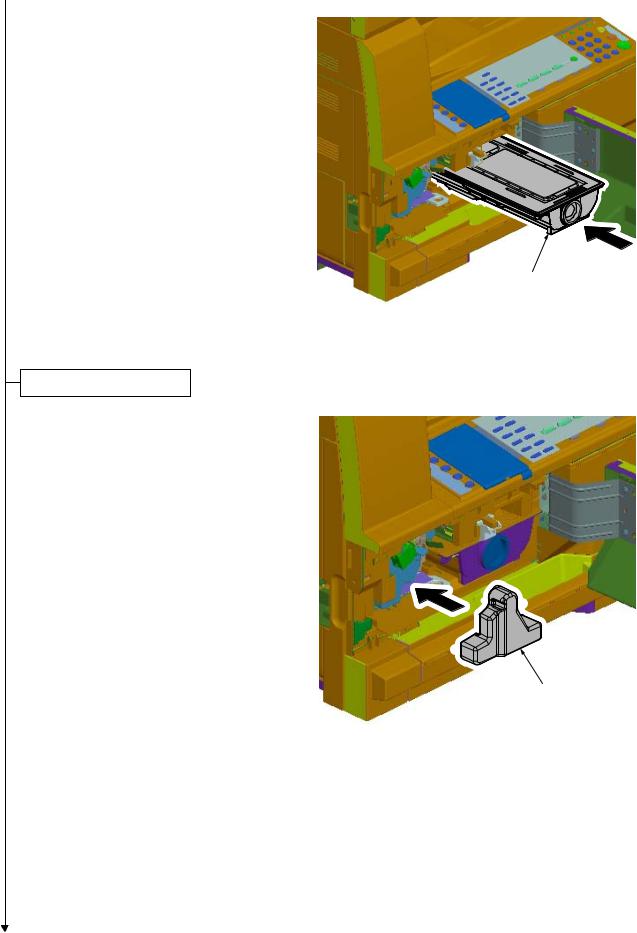
2KL/2KK
5.Gently push the toner container into the machine.
Push the container all the way into the machine until it locks in place.
Toner container
Figure 1-2-10
Install the waste toner box.
1.Install the waste toner box in the machine.
2.Close the front cover.
Waste toner box
Figure 1-2-11
1-2-7

2KL/2KK
Load paper.
1. Load paper in the cassette.
Connect the power cord.
1.Connect the power cord to the connector on the machine.
2.Insert the power plug into the wall outlet.
Installing toner.
1.Turn the main power switch on. Toner installation is started.
2.The drive chain is disengaged when toner installation is completed.
Run maintenance mode U130 if [Add Toner] remains displayed even after the drive chain is disengaged.
Output an own-status report (maintenance item U000).
1.Enter the maintenance mode by entering 10871087 using the numeric keys.
2.Enter 000 using the numeric keys and press the start key.
3.Select d-L and press the start key to output a list of the current settings of the maintenance items.
4.Press the stop/clear key.
Exit maintenance mode.
1.Enter 001 using the numeric keys and press the start key. The machine exits the maintenance mode.
Make test copies.
1. Place an original and make test copies.
Attaching the operation label.
1.According to need, attach the correspond operation label.
1-2-8

Attaching the cover label.
1.Attach the cover labels to three screw holes in the machine.
Right side: Two Left side: One
2KL/2KK
Right side

 Cover
Cover
label

 Cover
Cover
label
Left side
Cover label
Figure 1-2-12
Completion of the machine installation.
1-2-9
2KL/2KK-1
(2) Setting initial copy modes
Factory settings are as follows:
Maintenance |
Contents |
Factory setting |
|
item No. |
|||
|
|
||
|
|
|
|
U253 |
Switching between double and single counts |
DOUBLE COUNT(A3/LEDGER) |
|
U254 |
Turning auto start function on/off |
ON |
|
U260 |
Selecting the timing for copy counting |
After ejection |
|
U277 |
Setting auto application change time |
30 s |
|
U285 |
Setting service status page |
ON |
|
U342 |
Setting the ejection restriction |
ON |
|
U343 |
Switching between duplex/simplex copy mode |
OFF |
|
U344 |
Setting the low-power mode |
ENERGY STAR (inch specifications) |
|
|
|
GEEA (metric specifications) |
|
|
|
|
1-2-10
